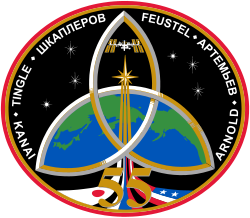Scott Tingle
| Scott Tingle | |
|---|---|
 | |
| Land | |
| Organisation | |
| ausgewählt | 29. Juni 2009 (20. NASA-Gruppe) |
| Einsätze | 1 Raumflug |
| Start | 17. Dezember 2017 |
| Landung | 3. Juni 2018 |
| Zeit im Weltraum | 168d 5h 18min |
| Raumflüge | |
| |
Scott David Tingle (* 19. Juli 1965 in Attleboro, Massachusetts) ist ein US-amerikanischer Astronaut.
Astronautentätigkeit
Tingle wurde am 29. Juni 2009 in die 20. NASA-Astronautengruppe gewählt. Die Grundausbildung schloss er im Juni 2011 ab.
Tingle startete am 17. Dezember 2017 als Bordingenieur des Raumschiffes Sojus MS-07 zusammen mit Anton Schkaplerow und Norishige Kanai zur ISS. Dort arbeitete er als Bordingenieur der ISS-Expeditionen 54 und 55. Die Rückkehr zur Erde erfolgte am 3. Juni 2018.
Im Dezember 2020 wurde er als Kandidat für Mondflüge im Rahmen des Artemis-Programms ausgewählt.[1]
Privates
Tingle ist verheiratet und hat drei Kinder.
Weblinks
- Scott Tingle auf der NASA-Website – Biografie, Bilder und Videos (englisch; PDF)
- Spacefacts: Kurzbiografie
Einzelnachweise
- ↑ William Harwood: NASA names 18 astronauts for Artemis moon missions. Spaceflight Now, 9. Dezember 2020.
| Personendaten | |
|---|---|
| NAME | Tingle, Scott |
| ALTERNATIVNAMEN | Tingle, Scott David (vollständiger Name) |
| KURZBESCHREIBUNG | US-amerikanischer Astronaut |
| GEBURTSDATUM | 19. Juli 1965 |
| GEBURTSORT | Attleboro, Massachusetts |
Auf dieser Seite verwendete Medien
The Expedition 54 crew insignia
- Orbiting Earth continuously since 1998, the International Space Station (ISS) is one of our greatest engineering achievements. It is depicted in gold, symbolic of constancy and excellence. Flying toward a sunrise represents the station’s contributions to a bright future. That sunrise uses blue, white, and red, the combined national colors of Japan, Russia, and the United States, symbolizing the crew’s cohesiveness. Crewmember names are in blue, symbolizing devotion and loyalty.
- The gold border represents the constant human presence in space onboard the orbiting laboratory. Symbolic of new Russian and U.S. spacecraft that will advance human exploration, the patch is shaped as a capsule. The number 54 is drawn as a path eventually leading to Mars.
- Finally, the stars symbolize the values of leadership, trust, teamwork, and excellence lived by mission control teams throughout the history of human space programs, as well as the global vigilance of those teams while operating the station.
Official astronaut portrait of Expedition 54/55 crew member Scott Tingle in an EMU.
The official mission insignia of the Expedition 55 crew.
- The six crew members of Expedition 55 are patriots from three different countries – Japan, Russia, and the United States. The crew from these three countries will work together to ensure the success of Expedition 55.
- The three rings symbolize the three countries of the six crew members. The rings join in a common intersection, symbolizing collaboration and a common focus for the crew aboard the space station. The colors of the rings represent the energy and power required to carry humans and equipment into space and to operate the ISS. The colors blue and green represent the magnificent beauty of Earth. The color black represents the darkness of space, and the immense challenge of exploring space. The six stars represent the crew, Norishige Kanai, Scott Tingle, Anton Shkaplerov, A.J. (Drew) Feustel, Oleg Artemyev, and Ricky Arnold. The three flags are the flags representing each crew member’s country. The swoosh extending upward towards space represents the dedication of cosmonauts, astronauts and a multinational support team working together to explore space and discover new science that will benefit all humans.




